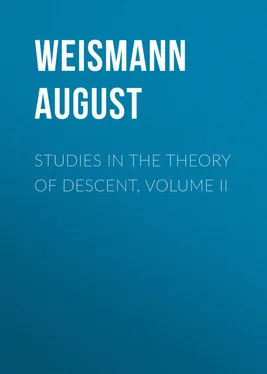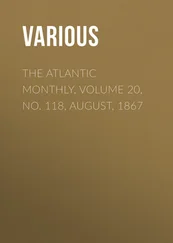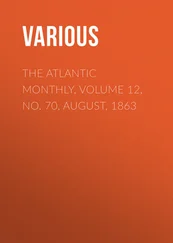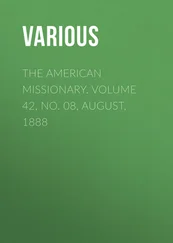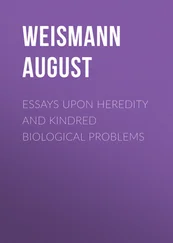August Weismann - Studies in the Theory of Descent, Volume II
Здесь есть возможность читать онлайн «August Weismann - Studies in the Theory of Descent, Volume II» — ознакомительный отрывок электронной книги совершенно бесплатно, а после прочтения отрывка купить полную версию. В некоторых случаях можно слушать аудио, скачать через торрент в формате fb2 и присутствует краткое содержание. Жанр: foreign_antique, foreign_prose, на английском языке. Описание произведения, (предисловие) а так же отзывы посетителей доступны на портале библиотеки ЛибКат.
- Название:Studies in the Theory of Descent, Volume II
- Автор:
- Жанр:
- Год:неизвестен
- ISBN:нет данных
- Рейтинг книги:4 / 5. Голосов: 1
-
Избранное:Добавить в избранное
- Отзывы:
-
Ваша оценка:
- 80
- 1
- 2
- 3
- 4
- 5
Studies in the Theory of Descent, Volume II: краткое содержание, описание и аннотация
Предлагаем к чтению аннотацию, описание, краткое содержание или предисловие (зависит от того, что написал сам автор книги «Studies in the Theory of Descent, Volume II»). Если вы не нашли необходимую информацию о книге — напишите в комментариях, мы постараемся отыскать её.
Studies in the Theory of Descent, Volume II — читать онлайн ознакомительный отрывок
Ниже представлен текст книги, разбитый по страницам. Система сохранения места последней прочитанной страницы, позволяет с удобством читать онлайн бесплатно книгу «Studies in the Theory of Descent, Volume II», без необходимости каждый раз заново искать на чём Вы остановились. Поставьте закладку, и сможете в любой момент перейти на страницу, на которой закончили чтение.
Интервал:
Закладка:
That caterpillars can also vary locally without thereby affecting the imagines is shown by the frequently mentioned and closely investigated cases of di- and polymorphism in the larvæ of a number of Sphingidæ ( M. Stellatarum , A. Atropos , S. Convolvuli , C. Elpenor , and Porcellus , &c.). The same thing is still more clearly shown by those instances in which there are not several but only one distinct larval form occurring in each of two different localities.
To this class belongs the above-mentioned case of Chærocampa Celerio (p. 197), supposing our information concerning this species to be correct; likewise the recently-mentioned case of the Ligurian variety of the caterpillar of Saturnia Carpini ; and finally the case of Eriogaster Lanestris , so well known to lepidopterists. This insect inhabits the plains of Germany, and in the Alps extends to an elevation of 7000 feet, where it possesses a larva differently marked and coloured ( E. Arbusculæ ) to those of the lowlands whilst the moths are smaller, but do not differ in other respects from those of the plains.
Among the Alpine species many other such cases may occur, but these could only be discovered by making investigations having special reference to this point. Of the Alpine butterflies, for example, not a single species can have been reared from the caterpillar; for this reason but few observations have on the whole been given by entomologists respecting the Alpine larvæ, which are not known sufficiently well to enable such a question to be decided.
The investigation of the form-relationships existing between larvæ on the one hand and imagines on the other has thus led to the following results: —
We learn on comparison that incongruences or inequalities of form-relationship occur in all systematic groups from varieties to families. These incongruences are of two kinds, in some cases being disclosed by the fact that the larvæ of two systematic groups, e. g. two species, are more closely related in form than their imagines (or inversely), whilst in other cases the larvæ form different systematic groups to those formed by the imagines.
The results of the investigation into the occurrence of incongruences among the various systematic groups may be thus briefly summarised: —
Incongruences appear to occur most frequently among varieties, since it very frequently happens that it is only the larva or only the imago which has diverged into a variety, the other stage remaining monomorphic. The systematic division of varieties is thus very often one-sided.
Among species also incongruences are of frequent occurrence. Sometimes the imagines are much more nearly related in form than the larvæ, and at others the reverse happens; whilst again the case appears also to occur in which only the one stage (larva) diverges to the extent of specific difference, the other stage remaining monomorphic ( D. Euphorbiæ and Nicæa ).
The agreement in form-relationship appears to be most complete in genera. In the greater number of cases the larval and imaginal genera coincide, not only in the sharpness of their limits, but also – as far as one can judge – in the weight of their distinctive characters, and therefore in the amount of their divergence. Of all the systematic groups, genera show the greatest congruence.
In families there is again an increase of irregularity. Although larval and imaginal families generally agree, there are so many exceptions that the groups would be smaller if they were based exclusively on the larval structure than if founded entirely on the imagines ( Nymphalidæ , Bombycidæ ).
If we turn to the groups of families we find a considerably increased incongruence; complete agreement is here again rather the exception, and it further happens in these cases that it is always the larvæ which, to a certain extent, remain at a lower grade, and which form well defined families; but these can seldom be associated into groups of a higher order having a common character, as in the case of the imagines ( Rhopalocera ).
After having thus collected (so far as I am able) the facts, we have now to attempt their interpretation, and from the observed congruence and incongruence of form-relationship of the two stages to endeavour to draw a conclusion as to the underlying causes of the transformations.
It is clear at starting that all cases of incongruence can only be the expression or the consequence of a phyletic development which has not been exactly parallel in the two stages of larva and imago – that one stage must have changed either more rapidly or more slowly than the other. An “unequal phyletic development” is thus the immediate cause of incongruence.
Thus, the occurrence of different larvæ in species of which the imagines have remained alike may be simply understood as cases in which the imago only has experienced a change – has taken a forward step in phyletic development, whilst the larvæ have remained behind. If we conceive this one-sided development to be repeated several times, there would arise two larval forms as widely different as those of Deilephila Nicæa , and Euphorbiæ , whilst the imagines, as is actually the case in these species, would remain the same.
The more commonly occurring case in which one stage has a greater form-divergence than the other, is explicable by the one stage having changed more frequently or more strongly than the other.
The explanation of the phenomena thus far lies on the surface, and it is scarcely possible to advance any other; but why should one stage become changed more frequently or to a greater extent than the other? why should one portion be induced to change more frequently or more strongly than another? whence come these inducements to change? These questions bring us to the main point of inquiry: – Are the causes which give rise to these changes internal or external? Are the latter the result of a phyletic vital force, or are they only due to the action of the external conditions of life?
Although an answer to this question will be found in the preceding essay, I will not support myself on the results there obtained, but will endeavour to give another solution of the problem on fresh grounds. The answer will indeed be the same as before: – A phyletic force must be discountenanced, since in the first place it does not explain the phenomena, and in the second place the phenomena can be well explained without its assumption.
The admission of a phyletic vital force does not explain the phenomena. The assumption that there is a transforming power innate in the organism indeed agrees quite well with the phenomenon of congruence, but not with that of incongruence. Since a large number of cases of the latter depend upon the fact that the larvæ are more frequently influenced by causes of change than their imagines, or vice versâ , how can this be reconciled with such an internal force? On this assumption would not each stage of a species be compelled to change, if not contemporaneously at least successively, with the same frequency and intensity, by the action of an innate force? and how by means of the latter can there ever result a greater form-divergence in the larvæ than in the imagines?
It is delusive to believe that these unequal deviations can be explained by assuming that the phyletic force acts periodically. Granting that it does so, and that the internal power successively compels the imago, pupa, and finally the larva to change, there would then pass a kind of wave of transformation over the different stages of the species, as was actually shown above to be the case in the single larval stages. The only possible way of explaining the unequal distances between larvæ and imagines would therefore be to assume that two allied groups, e. g. species, were not contemporaneously affected by the wave, so that at a certain period of time the imago alone of one species had become changed, whilst in the other species the wave of transformation had also reached the larva. In this case the imagines of the two species would thus appear to be more nearly related than their larvæ.
Читать дальшеИнтервал:
Закладка:
Похожие книги на «Studies in the Theory of Descent, Volume II»
Представляем Вашему вниманию похожие книги на «Studies in the Theory of Descent, Volume II» списком для выбора. Мы отобрали схожую по названию и смыслу литературу в надежде предоставить читателям больше вариантов отыскать новые, интересные, ещё непрочитанные произведения.
Обсуждение, отзывы о книге «Studies in the Theory of Descent, Volume II» и просто собственные мнения читателей. Оставьте ваши комментарии, напишите, что Вы думаете о произведении, его смысле или главных героях. Укажите что конкретно понравилось, а что нет, и почему Вы так считаете.
